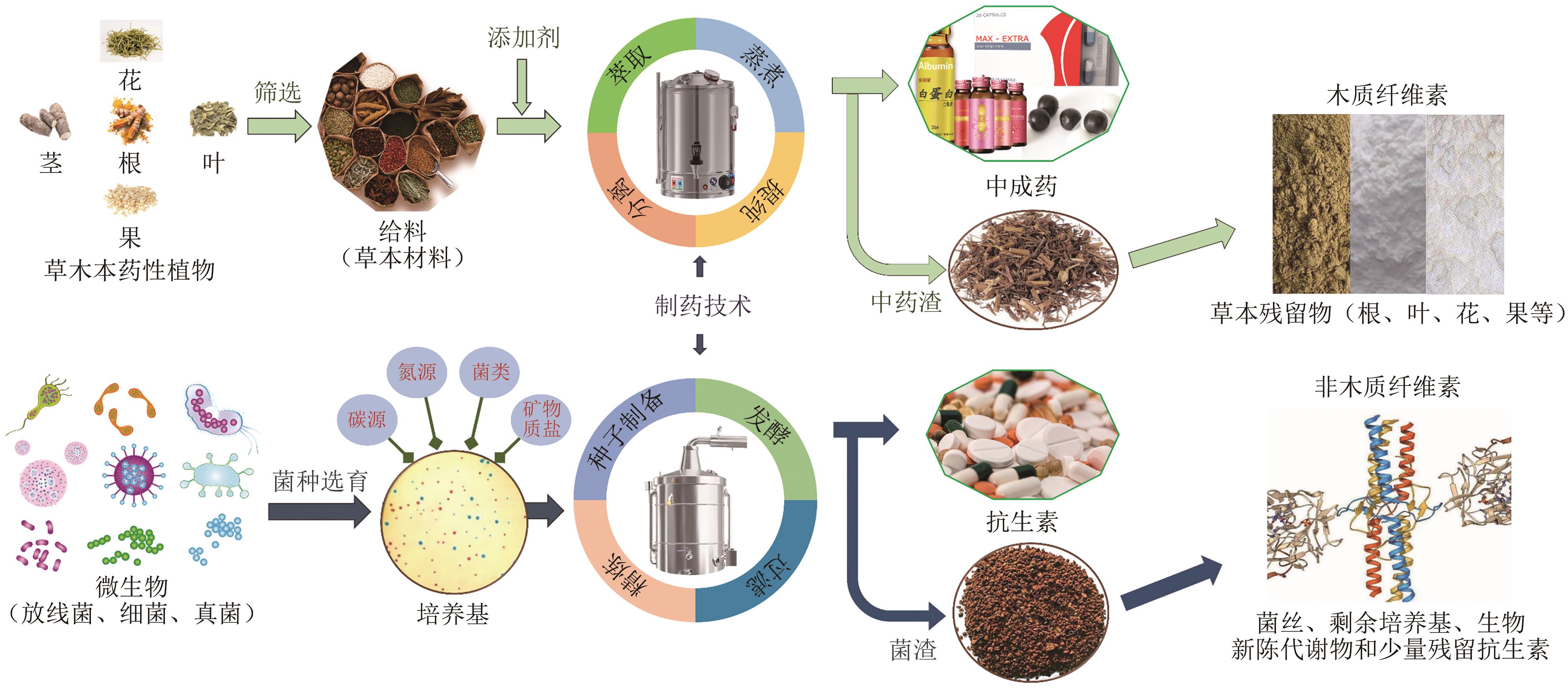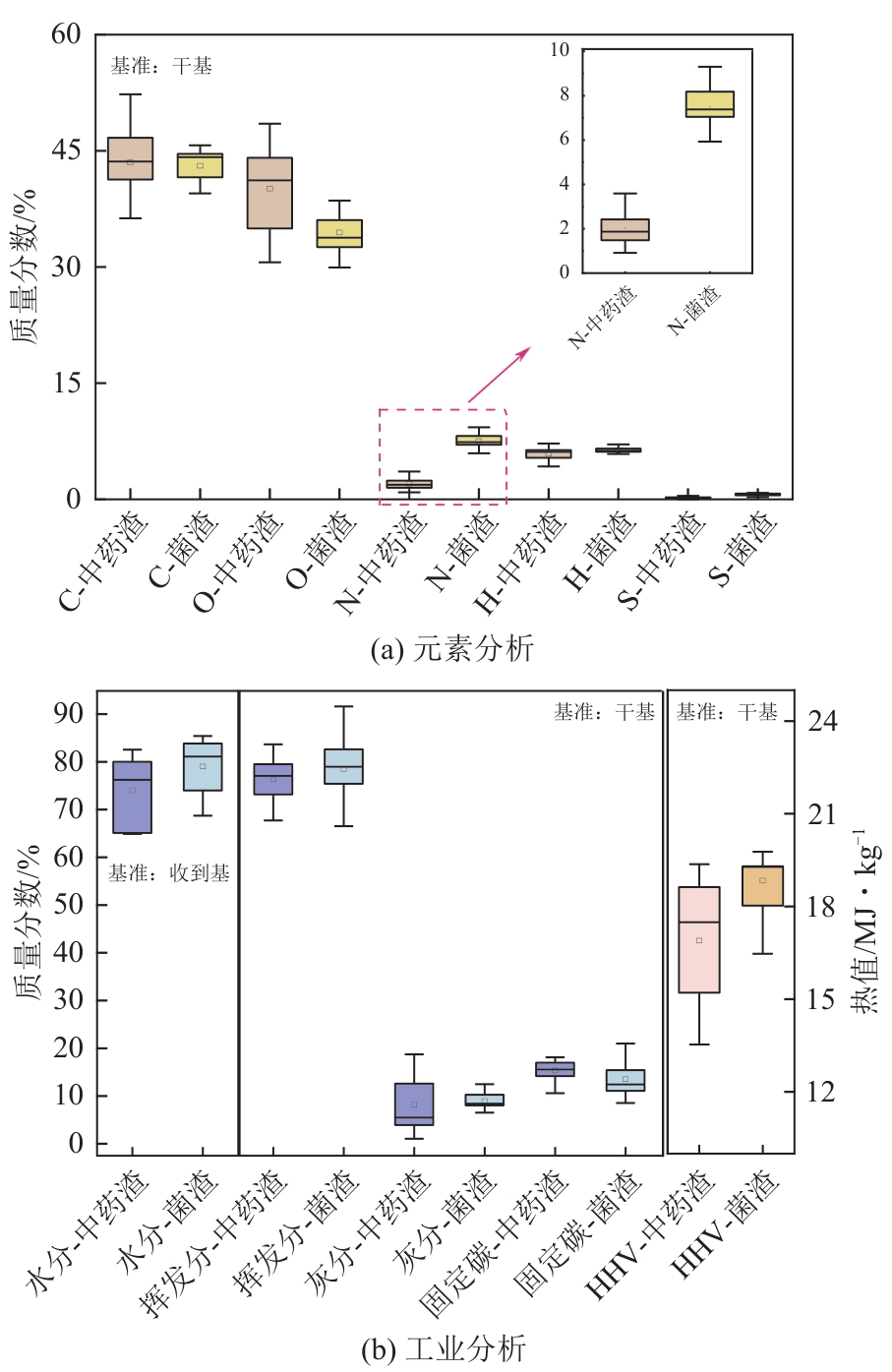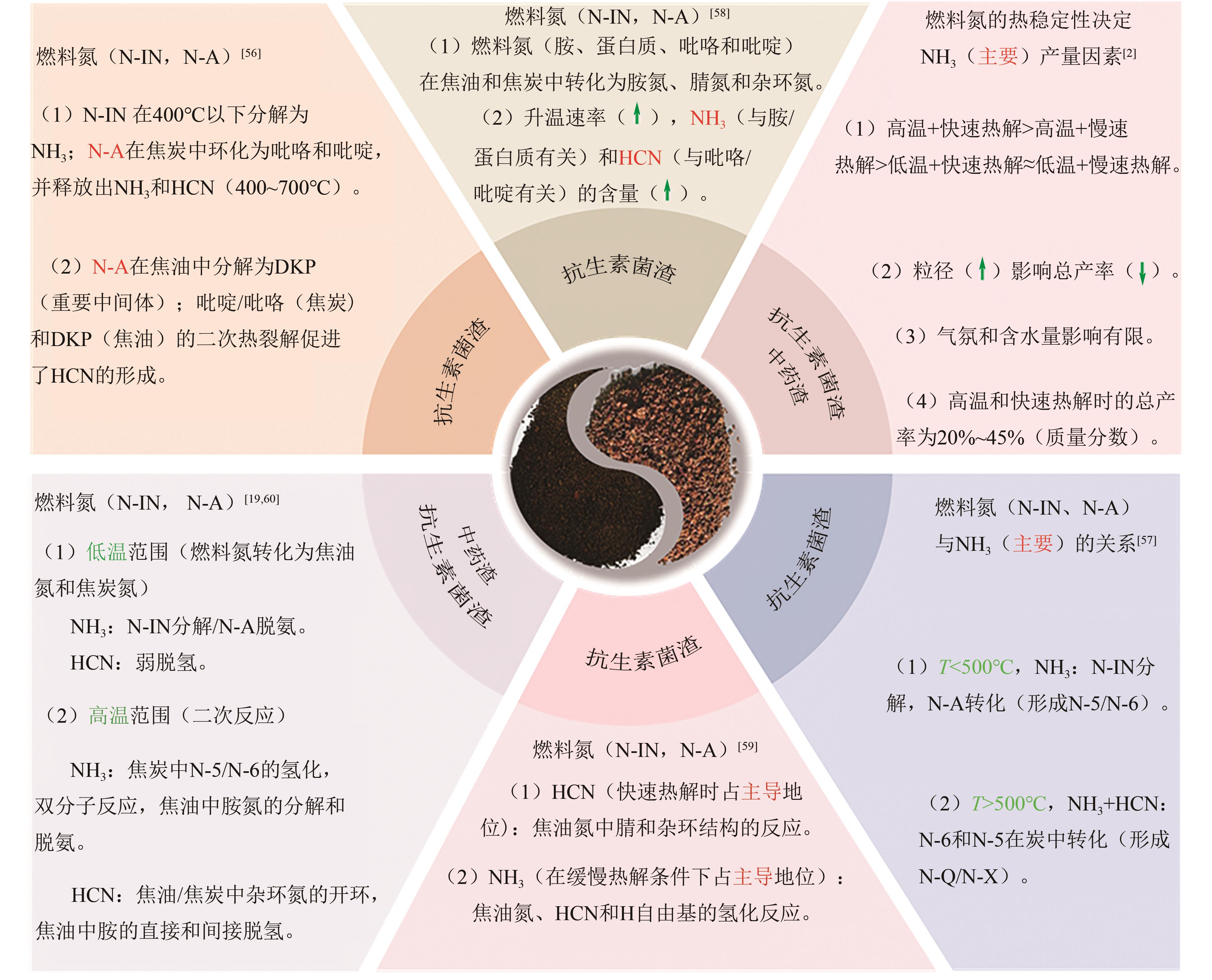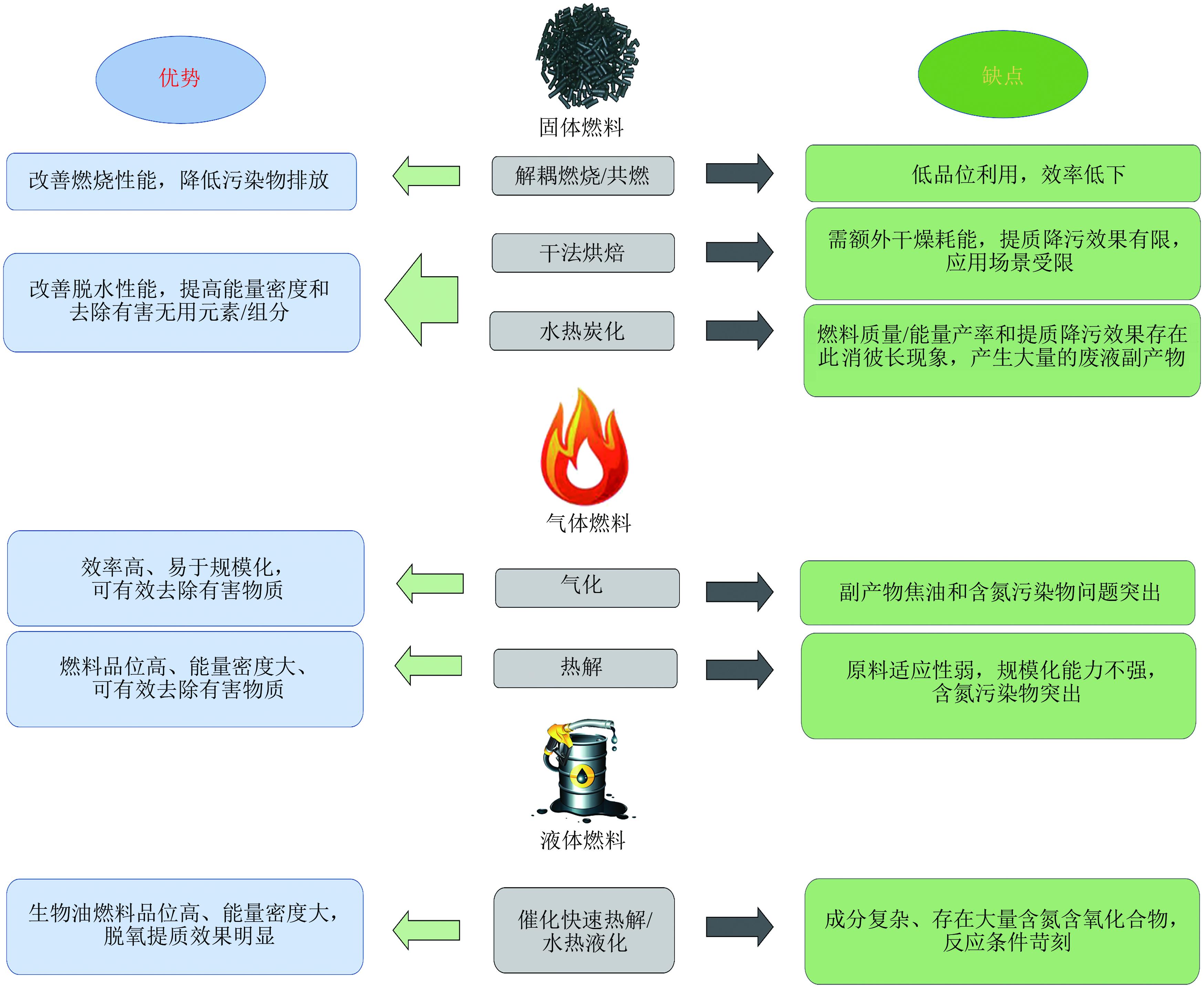Chemical Industry and Engineering Progress ›› 2025, Vol. 44 ›› Issue (1): 477-489.DOI: 10.16085/j.issn.1000-6613.2023-2284
• Resources and environmental engineering • Previous Articles Next Articles
Enhanced biofuels from pharmaceutical process residues: Thermo-chemical conversion characteristics and mechanisms
LIANG Xuebin( ), WEI Yilin, ZHOU Zhening, ZHAN Hao(
), WEI Yilin, ZHOU Zhening, ZHAN Hao( ), ZENG Zhiyong, LENG Lijian, PENG Haoyi
), ZENG Zhiyong, LENG Lijian, PENG Haoyi
- School of Energy Science and Engineering, Central South University, Changsha 410083, Hunan, China
-
Received:2023-12-28Revised:2024-03-15Online:2025-02-13Published:2025-01-15 -
Contact:ZHAN Hao
药渣衍生改性燃料:热化学转化规律与机制
梁学斌( ), 卫怡琳, 周哲宁, 詹昊(
), 卫怡琳, 周哲宁, 詹昊( ), 曾志勇, 冷立健, 彭好义
), 曾志勇, 冷立健, 彭好义
- 中南大学能源科学与工程学院,湖南 长沙 410083
-
通讯作者:詹昊 -
作者简介:梁学斌(2001—),男,硕士研究生,研究方向为有机固废热化学转化。E-mail:451156531@qq.com。 -
基金资助:国家自然科学基金(51906247);湖南省自然科学基金(2023JJ30691)
CLC Number:
Cite this article
LIANG Xuebin, WEI Yilin, ZHOU Zhening, ZHAN Hao, ZENG Zhiyong, LENG Lijian, PENG Haoyi. Enhanced biofuels from pharmaceutical process residues: Thermo-chemical conversion characteristics and mechanisms[J]. Chemical Industry and Engineering Progress, 2025, 44(1): 477-489.
梁学斌, 卫怡琳, 周哲宁, 詹昊, 曾志勇, 冷立健, 彭好义. 药渣衍生改性燃料:热化学转化规律与机制[J]. 化工进展, 2025, 44(1): 477-489.
share this article
Add to citation manager EndNote|Ris|BibTeX
URL: https://hgjz.cip.com.cn/EN/10.16085/j.issn.1000-6613.2023-2284
| 1 | ZHANG Wenyi. Total operating revenue of China’s pharmaceutical industry 2013-2022[EB/OL]. (2023-08-07)[2024-03-13]. . |
| 2 | 詹昊, 阴秀丽, 黄艳琴, 等. 药渣热解过程NO x 前驱物生成特征及规律研究[J]. 燃料化学学报, 2017, 45(3): 279-288. |
| ZHAN Hao, YIN Xiuli, HUANG Yanqin, et al. Characteristics of NO x precursors and their formation mechanism during pyrolysis of herb residues[J]. Journal of Fuel Chemistry and Technology, 2017, 45(3): 279-288. | |
| 3 | TAO Weiyi, JIN Junjie, ZHENG Yanping, et al. Current advances of resource utilization of herbal extraction residues in China[J]. Waste and Biomass Valorization, 2021, 12(11): 5853-5868. |
| 4 | YANG Guang, WANG Jianlong, SHEN Yunpeng. Antibiotic fermentation residue for biohydrogen production using different pretreated cultures: Performance evaluation and microbial community analysis[J]. Bioresource Technology, 2019, 292: 122012. |
| 5 | CHEN Wei, GENG Yong, HONG Jianlan, et al. Life cycle assessment of antibiotic mycelial residues management in China[J]. Renewable and Sustainable Energy Reviews, 2017, 79: 830-838. |
| 6 | TRIPATHY Vandana, BASAK B B, VARGHESE Thania Sara, et al. Residues and contaminants in medicinal herbs—A review[J]. Phytochemistry Letters, 2015, 14: 67-78. |
| 7 | STEPHEN Jilu Lizy, PERIYASAMY Balasubramanian. Innovative developments in biofuels production from organic waste materials: A review[J]. Fuel, 2018, 214: 623-633. |
| 8 | CHEN Zhiyun, CHEN Huashan, WU Xieyuan, et al. Temperature- and heating rate-dependent pyrolysis mechanisms and emissions of Chinese medicine residues and numerical reconstruction and optimization of their non-linear dynamics[J]. Renewable Energy, 2021, 164: 1408-1423. |
| 9 | ZHUANG Xiuzheng, ZHAN Hao, SONG Yanpei, et al. Insights into the evolution of chemical structures in lignocellulose and non-lignocellulose biowastes during hydrothermal carbonization (HTC)[J]. Fuel, 2019, 236: 960-974. |
| 10 | WEI Haolin, BU Jie, ZHOU Shishui, et al. A facile ionic liquid and p-toluenesulfonic acid pretreatment of herb residues: Enzymatic hydrolysis and lignin valorization[J]. Chemical Engineering Journal, 2021, 419: 129616. |
| 11 | MENG Xiaoyan, WEN Zongguo, QIAN Yi, et al. Evaluation of cleaner production technology integration for the Chinese herbal medicine industry using carbon flow analysis[J]. Journal of Cleaner Production, 2017, 163: 49-57. |
| 12 | HONG Chen, WANG Zhiqiang, SI Yanxiao, et al. Preparation of bio-oils by hydrothermal liquefaction (HTL) of penicillin fermentation residue (PR): Optimization of conditions and mechanistic studies[J]. Science of The Total Environment, 2021, 761: 143216. |
| 13 | GUO Feiqiang, DONG Yuping, DONG Lei, et al. An innovative example of herb residues recycling by gasification in a fluidized bed. Waste Management[J]. 2013, 33(4): 825-832. |
| 14 | ZENG Xi, DONG Yuping, WANG Fang, et al. Fluidized bed two-stage gasification process for clean fuel gas production from herb residue: Fundamentals and demonstration[J]. Energy & Fuels, 2016, 30(9): 7277-7283. |
| 15 | GUAN Haibin, FAN Xiaoxu, ZHAO Baofeng, et al. An experimental investigation on biogases production from Chinese herb residues based on dual circulating fluidized bed[J]. International Journal of Hydrogen Energy, 2018, 43(28): 12618-12626. |
| 16 | XIN Shanzhi, HUANG Fang, LIU Xiaoye, et al. Torrefaction of herbal medicine wastes: Characterization of the physicochemical properties and combustion behaviors[J]. Bioresource Technology, 2019, 287: 121408. |
| 17 | YANG Zhongyu, BAI Mengyuan, HAN Tong, et al. Application potential of antibiotic fermentation residue for co-combustion with coal: Thermal behavior, gaseous products, and kinetics[J]. Fuel, 2023, 335: 126953. |
| 18 | HUANG Shengxiong, SU Yifeng, LUO Wei, et al. Kinetic analysis and in-situ no support catalytic pyrolysis product distribution of Chinese herb residue[J]. Journal of Analytical and Applied Pyrolysis, 2021, 156: 105114. |
| 19 | ZHAN Hao, YIN Xiuli, HUANG Yanqin, et al. NO x precursors evolving during rapid pyrolysis of lignocellulosic industrial biomass wastes[J]. Fuel, 2017, 207: 438-448. |
| 20 | GUO Feiqiang, DONG Yuping, Zhaochuan LYU, et al. Pyrolysis kinetics of biomass (herb residue) under isothermal condition in a micro fluidized bed[J]. Energy Conversion and Management, 2015, 93: 367-376. |
| 21 | ZHANG Bo, ZHANG Jing. Influence of reaction atmosphere (N2, CO, CO2, and H2) on ZSM-5 catalyzed microwave-induced fast pyrolysis of medicinal herb residue for biofuel production[J]. Energy & Fuels, 2017, 31(9): 9627-9632. |
| 22 | DING Yan, LI Yunchao, DAI Yujie, et al. A novel approach for preparing in-situ nitrogen doped carbon via pyrolysis of bean pulp for supercapacitors[J]. Energy, 2021, 216: 119227. |
| 23 | MENG Fanjing, YANG Shaoguo, WANG Xin, et al. Reclamation of Chinese herb residues using probiotics and evaluation of their beneficial effect on pathogen infection[J]. Journal of Infection and Public Health, 2017, 10(6): 749-754. |
| 24 | YUAN Donghai, CUI Yanqi, KOU Yingying, et al. Environmental risk and management of herbal-extraction residues induced by the composition and metal binding properties of DOM[J]. Frontiers in Environmental Science, 2022, 10:856308. |
| 25 | YANG Shijun, ZHU Xiangdong, WANG Junsheng, et al. Combustion of hazardous biological waste derived from the fermentation of antibiotics using TG-FTIR and Py-GC/MS techniques[J]. Bioresource Technology, 2015, 193: 156-163. |
| 26 | ZHANG Guangyi, LIU Huan, GE Yaxin, et al. Gaseous emission and ash characteristics from combustion of high ash content antibiotic mycelial residue in fluidized bed and the impact of additional water vapor[J]. Fuel, 2017, 202: 66-77. |
| 27 | CHEN Hongfang, ZHAO Peitao, WANG Yin, et al. NO emission control during the decoupling combustion of industrial biomass wastes with a high nitrogen content[J]. Energy & Fuels, 2013, 27(6): 3186-3193. |
| 28 | ZHUANG Xiuzheng, SONG Yanpei, ZHAN Hao, et al. Synergistic effects on the co-combustion of medicinal biowastes with coals of different ranks[J]. Renewable Energy, 2019, 140: 380-389. |
| 29 | DU Yuying, JIANG Xuguang, MA Xiaojun, et al. Evaluation of cofiring bioferment residue with coal at different proportions: Combustion characteristics and kinetics[J]. Energy & Fuels, 2013, 27(10): 6295-6303. |
| 30 | WANG Jianqian, LIU Jinzhong, JIN Yuqi, et al. Study on the slurry ability and combustion behaviour of coal-bioferment residue of drugs-slurry[J]. The Canadian Journal of Chemical Engineering, 2018, 96(4): 838-844. |
| 31 | 洪晨, 杨强, 王志强, 等. 抗生素菌渣与煤混合燃烧特性及其动力学分析[J]. 化工学报, 2017, 68(1): 360-368. |
| HONG Chen, YANG Qiang, WANG Zhiqiang, et al. Co-combustion characteristics and kinetic analysis of antibiotic bacterial residue and coal[J]. CIESC Journal, 2017, 68(1): 360-368. | |
| 32 | WANG Chang’an, JIN Liyan, WANG Yikun, et al. Thermogravimetric investigation on co-combustion characteristics and kinetics of antibiotic filter residue and vegetal biomass[J]. Journal of Thermal Analysis and Calorimetry, 2022, 147(1): 925-938. |
| 33 | CHEN Zhiyun, LIU Jingyong, CHEN Huashan, et al. Oxy-fuel and air atmosphere combustions of Chinese medicine residues: Performances, mechanisms, flue gas emission, and ash properties[J]. Renewable Energy, 2022, 182: 102-118. |
| 34 | 韩洪军, 牟晋铭, 马文成, 等. 微波辐射对青霉素菌渣破壁效果的影响[J]. 化工学报, 2013, 64(10): 3812-3817. |
| HAN Hongjun, MOU Jinming, MA Wencheng, et al. Effect of microwave on cell wall broken of penicillin fermentation residue[J]. CIESC Journal, 2013, 64(10): 3812-3817. | |
| 35 | CAI Chen, LIU Huiling, WANG Mengmeng. Characterization of antibiotic mycelial residue (AMR) dewatering performance with microwave treatment[J]. Chemosphere, 2017, 174: 20-27. |
| 36 | ZHANG Guangyi, MA Dachao, PENG Cuina, et al. Process characteristics of hydrothermal treatment of antibiotic residue for solid biofuel[J]. Chemical Engineering Journal, 2014, 252: 230-238. |
| 37 | GUO Chenchen, ZHOU Chang, LIU Xiaolin, et al. Dehydration kinetics of antibiotic fermentation residues by dehydration agents at room temperature[J]. Environmental Progress & Sustainable Energy, 2021, 40(4): e13596. |
| 38 | ZHOU Chang, LIU Xiaolin, LI Wangliang, et al. A novel process for dehydration of antibiotics fermentation residues[J]. Environmental Progress & Sustainable Energy, 2018, 37(6): 1959-1964. |
| 39 | YAN Beibei, JIAO Liguo, LI Jian, et al. Investigation on microwave torrefaction: Parametric influence, TG-MS-FTIR analysis, and gasification performance[J]. Energy, 2021, 220: 119794. |
| 40 | XIN Shanzhi, MI Tie, LIU Xiaoye, et al. Effect of torrefaction on the pyrolysis characteristics of high moisture herbaceous residues[J]. Energy, 2018, 152: 586-593. |
| 41 | AHMAD Shakeel, ZHU Xiangdong, LUO Jiewen, et al. Phosphorus and nitrogen transformation in antibiotic mycelial residue derived hydrochar and activated pyrolyzed samples: Effect on Pb(Ⅱ) immobilization[J]. Journal of Hazardous Materials, 2020, 393: 122446. |
| 42 | HU Jiashuo, HONG Chen, LI Zaixing, et al. Nitrogen release of hydrothermal treatment of antibiotic fermentation residue and preparation of struvite from hydrolysate[J]. Science of The Total Environment, 2020, 713: 135174. |
| 43 | MA Dachao, ZHANG Guangyi, ZHAO Peitao, et al. Hydrothermal treatment of antibiotic mycelial dreg: More understanding from fuel characteristics[J]. Chemical Engineering Journal, 2015, 273: 147-155. |
| 44 | MA Dachao, ZHANG Guangyi, AREEPRASERT Chinnathan, et al. Characterization of NO x emission in combustion of hydrothermally treated antibiotic mycelial residue[J]. Chemical Engineering Journal, 2016, 284: 708-715. |
| 45 | AHMAD Shakeel, ZHU Xiangdong, WEI Xinchao, et al. Characterization and potential applications of hydrochars derived from P- and N-enriched agricultural and antibiotic residues via microwave-assisted hydrothermal conversion[J]. Energy & Fuels, 2020, 34(9): 11154-11164. |
| 46 | CAI Chen, HUA Yu, LI Huiping, et al. Hydrothermal treatment of erythromycin fermentation residue: Harmless performance and bioresource properties[J]. Resources, Conservation and Recycling, 2020, 161: 104952. |
| 47 | ZHUANG Xiuzheng, ZHAN Hao, HUANG Yanqin, et al. Conversion of industrial biowastes to clean solid fuels via hydrothermal carbonization (HTC): Upgrading mechanism in relation to coalification process and combustion behavior[J]. Bioresource Technology, 2018, 267: 17-29. |
| 48 | ZHUANG Xiuzheng, ZHAN Hao, HUANG Yanqin, et al. Denitrification and desulphurization of industrial biowastes via hydrothermal modification[J]. Bioresource Technology, 2018, 254: 121-129. |
| 49 | ZHAN Hao, ZHUANG Xiuzheng, ZHANG Shihui, et al. Evaluation on the enhanced solid biofuel from co-hydrothermal carbonization of pharmaceutical biowastes with lignite[J]. Fuel, 2022, 318: 123626. |
| 50 | ZHAN Hao, ZHANG Shihui, SONG Yanpei, et al. Hydrothermal co-carbonization of industrial biowastes with lignite toward modified hydrochar production: Synergistic effects and structural characteristics[J]. Journal of Environmental Chemical Engineering, 2022, 10(3): 107540. |
| 51 | WANG Zhiqiang, HONG Chen, XING Yi, et al. Thermal characteristics and product formation mechanism during pyrolysis of penicillin fermentation residue[J]. Bioresource Technology, 2019, 277: 46-54. |
| 52 | DU Y, JIANG X, MA X, et al. Pyrolysis product evolution characteristics of bio-ferment residue using thermogravimetric analysis, fourier transform infrared spectroscopy, and mass spectrometry[J]. Journal of Applied Spectroscopy, 2015, 81(6): 1073-1077. |
| 53 | LIN Yousheng, XIAO Hanmin, CHEN Baiman, et al. Thermal behavior and general distributed activation energy model kinetics of lignite-Chinese herb residues blends during co-pyrolysis[J]. Bioresource Technology, 2020, 304: 122991. |
| 54 | MI T, YU X M. Study on pyrolysis characteristics of medical waste[J]. Journal of the Energy Institute, 2012, 85(3): 170-175. |
| 55 | 冯丽慧, 邢奕, 杨鹏宇. 抗生素菌渣热解及气态污染物排放特性的研究[J]. 安全与环境工程, 2018, 25(4): 89-96. |
| FENG Lihui, XING Yi, YANG Pengyu. Characteristics of pyrolysis and gaseous pollutant emissions of antibiotic bacterial residue[J]. Safety and Environmental Engineering, 2018, 25(4): 89-96 | |
| 56 | LI Yifei, HONG Chen, WANG Yijie, et al. Nitrogen migration mechanism during pyrolysis of penicillin fermentation residue based on product characteristics and quantum chemical analysis[J]. ACS Sustainable Chemistry & Engineering, 2020, 8(20): 7721-7740. |
| 57 | 詹昊, 林均衡, 黄艳琴, 等. 抗生素菌渣热解N官能团变化特征及其与NO x 前驱物关系研究[J]. 燃料化学学报, 2017, 45(10): 1219-1229. |
| ZHAN Hao, LIN Junheng, HUANG Yanqin, et al. Evolution of nitrogen functionalities and their relation to NO x precursors during pyrolysis of antibiotic mycelia wastes[J]. Journal of Fuel Chemistry and Technology, 2017, 45(10): 1219-1229. | |
| 58 | ZHU Xiangdong, YANG Shijun, WANG Liang, et al. Tracking the conversion of nitrogen during pyrolysis of antibiotic mycelial fermentation residues using XPS and TG-FTIR-MS technology[J]. Environmental Pollution, 2016, 211: 20-27. |
| 59 | CHEN Hongfang, WANG Yin, XU Guangwen, et al. Fuel-N evolution during the pyrolysis of industrial biomass wastes with high nitrogen content[J]. Energies, 2012, 5(12): 5418-5438. |
| 60 | ZHAN Hao, ZHUANG Xiuzheng, SONG Yanpei, et al. Insights into the evolution of fuel-N to NO x precursors during pyrolysis of N-rich nonlignocellulosic biomass[J]. Applied Energy, 2018, 219: 20-33. |
| 61 | ZHAN Hao, ZHUANG Xiuzheng, SONG Yanpei, et al. Evolution of nitrogen functionalities in relation to NO x precursors during low-temperature pyrolysis of biowastes[J]. Fuel, 2018, 218: 325-334. |
| 62 | ZHAN Hao, ZHUANG Xiuzheng, SONG Yanpei, et.al. Step pyrolysis of N-rich industrial biowastes: Regulatory mechanism of NO x precursor formation via exploring decisive reaction pathways[J]. Chemical Engineering Journal, 2018, 344: 320-331. |
| 63 | DING Weijing, ZHANG Xiaodong, ZHAO Baofeng, et al. TG-FTIR and thermodynamic analysis of the herb residue pyrolysis with in-situ CO2 capture using CaO catalyst[J]. Journal of Analytical and Applied Pyrolysis, 2018, 134: 389-394. |
| 64 | ZHAO Baofeng, ZHANG Xiaodong, XU Anzhuang, et al. A study of the in-situ CO2 removal pyrolysis of Chinese herb residue for syngas production[J]. Science of The Total Environment, 2018, 626: 703-709. |
| 65 | XU Anzhuang, ZHOU Weihong, ZHANG Xiaodong, et al. Gas production by catalytic pyrolysis of herb residues using Ni/CaO catalysts[J]. Journal of Analytical and Applied Pyrolysis, 2018, 130: 216-223. |
| 66 | LI Tiantao, GUO Feiqiang, LI Xiaolei, et al. Characterization of herb residue and high ash-containing paper sludge blends from fixed bed pyrolysis[J]. Waste Management, 2018, 76: 544-554. |
| 67 | LI Jian, LIU Huanbo, JIAO Liguo, et al. Microwave pyrolysis of herb residue for syngas production with in-situ tar elimination and nitrous oxides controlling[J]. Fuel Processing Technology, 2021, 221: 106955. |
| 68 | ZHENG Yan, ZHANG Yimin, XU Jingna, et al. Co-pyrolysis behavior of fermentation residues with woody sawdust by thermogravimetric analysis and a vacuum reactor[J]. Bioresource Technology, 2017, 245: 449-455. |
| 69 | ZENG Xi, SHAO Ruyi, WANG Fang, et al. Industrial demonstration plant for the gasification of herb residue by fluidized bed two-stage process[J]. Bioresource Technology, 2016, 206: 93-98. |
| 70 | 范鹏飞, 李景东, 刘艳涛, 等. 感冒清热颗粒中药渣中试规模循环流化床气化实验[J]. 化工进展, 2014, 33(8): 1979-1985, 1991. |
| FAN Pengfei, LI Jingdong, LIU Yantao, et.al. Experimental study of gasification of herb residues of ganmaoqingre granules in pilot-scale dual-loop circulating fluidized bed[J]. Chemical Industry and Engineering Progress 2014, 33(8): 1979-1985, 1991. | |
| 71 | 董玉平, 张彤辉, 常加富, 等. 中药渣双回路循环流化床气化试验[J]. 天然气工业, 2013, 33(10): 127-132. |
| DONG Yuping, ZHANG Tonghui, CHANG Jiafu, et al. An experimental study of Chinese herb residues in a circulating fluidized bed with a secondary back feeding device[J] Nature Gas Industry, 2013, 33(10): 127-132. | |
| 72 | GUO Feiqiang, DONG Yuping, ZHANG Tonghui, et al. Experimental study on herb residue gasification in an air-blown circulating fluidized bed gasifier[J]. Industrial & Engineering Chemistry Research, 2014, 53(34): 13264-13273. |
| 73 | WANG Xutong, CUI Xiaoqiang, CHE Yuechi, et al. Gasification of Tibetan herb residue: Thermogravimetric analysis and experimental study[J]. Biomass and Bioenergy, 2021, 146: 105952. |
| 74 | GUO Qianqian, LI Jian, CHEN Guanyi, et al. A comprehensive comparison study: The impacts of gasifying agents and parameters on Chinese herb medicine residue gasification[J]. Waste and Biomass Valorization, 2021, 12(6): 3059-3073. |
| 75 | 汪印, 刘殊远, 任明威, 等. 基于流化床热解的中药渣两段气化基础研究[J]. 燃料化学学报, 2013, 41(3): 294-301. |
| WANG Yin, LIU Shuyuan, REN Mingwei, et al. Fundamental study on Chinese herb residue pyrolysis and gasification by combining fluidized bed and fixed bed[J] Journal of Fuel Chemistry and Technology, 2013, 41(3): 294-301. | |
| 76 | DONG Lei, TAO Junyu, ZHANG Zhaoling, et al. Energy utilization and disposal of herb residue by an integrated energy conversion system: A pilot scale study[J]. Energy, 2021, 215: 119192. |
| 77 | DU Yuying, JIANG Xuguang, MA Xiaojun, et al. Cogasification of biofermenting residue in a coal-water slurry gasifier[J]. Energy & Fuels, 2014, 28(3): 2054-2058. |
| 78 | LIU Fang, WU Xin, ZHANG Xi, et al. Co-use of organic herbal residue and red mud waste for syngas production by chemical looping gasification[J]. International Journal of Energy Research, 2021, 45(2): 2195-2210. |
| 79 | WANG Tipeng, PENG Li, AI Yinong, et al. Pyrolytic behaviors of decocting residues of Rhodiola rosea[J]. Journal of Analytical and Applied Pyrolysis, 2018, 129: 61-65. |
| 80 | ZHANG Chenting, ZHANG Zhanming, ZHANG Lijun, et al. Pyrolysis of herb waste: Effects of extraction pretreatment on characteristics of bio-oil and biochar[J]. Biomass and Bioenergy, 2020, 143: 105801. |
| 81 | XIN Shanzhi, HUANG Fang, QI Wei, et al. Pyrolysis of torrefied herbal medicine wastes: Characterization of pyrolytic products[J]. Energy, 2020, 210: 118455. |
| 82 | LEE Younghyun, KIM Soosan, KIM Jisu, et al. Catalytic pyrolysis as a technology to dispose of herbal medicine waste[J]. Catalysts, 2020, 10(8): 826. |
| 83 | LI Bo, QIAN Zehao, QIN Jie, et al. Products distribution during in situ and ex situ catalytic fast pyrolysis of Chinese herb residues[J]. Environmental Science and Pollution Research International, 2022, 29(59): 89235-89244. |
| 84 | XU Wei, GAO Lijing, YANG Hongmei, et al. Catalytic pyrolysis of distilled lemon grass over Ni-Al based oxides supported on MCM-41[J]. Energy Sources A: Recovery, Utilization, and Environmental Effects, 2020: 1-12. |
| 85 | WANG Pan, ZHAN Sihui, YU Hongbing, et al. The effects of temperature and catalysts on the pyrolysis of industrial wastes (herb residue)[J]. Bioresource Technology, 2010, 101(9): 3236-3241. |
| 86 | HUANG Shengxiong, QIN Jie, CHEN Tao, et al. Co-pyrolysis of different torrefied Chinese herb residues and low-density polyethylene: Kinetic and products distribution[J]. Science of the Total Environment, 2022, 802: 149752. |
| 87 | GUAN Haibin, DING Wenran, LIU Suxiang, et al. Catalytic hydrothermal liquefaction of Chinese herb residue for the production of high-quality bio-oil[J]. International Journal of Hydrogen Energy, 2023, 48(30): 11205-11213. |
| 88 | LI Yifei, HONG Chen, LI Zaixing, et al. Study on the nitrogen migration mechanism during penicillin fermentation residue fast pyrolysis based on the substance transformation and canonical variational theory[J]. Science of the Total Environment, 2020, 737: 139739. |
| 89 | ZHUANG Xiuzheng, ZHAN Hao, SONG Yanpei, et al. Reutilization potential of antibiotic wastes via hydrothermal liquefaction (HTL): Bio-oil and aqueous phase characteristics[J]. Journal of the Energy Institute, 2019, 92(5): 1537-1547. |
| 90 | YANG Jian, HONG Chen, LI Zaixing, et al. Study on hydrothermal liquefaction of antibiotic residues for bio-oil in ethanol-water system[J]. Waste Management, 2021, 120: 164-174. |
| 91 | LI Hu, GUO Haixin, FANG Zhen, et al. Cycloamination strategies for renewable N-heterocycles[J]. Green Chemistry, 2020, 22(3): 582-611. |
| [1] | LI Xinyue, LI Zhenjing, HAN Yihang, GUO Yongqiang, YAN Yu, KAREMULATI Halimire, ZHAO Huiji, CHAI Yongming, LIU Dong, YIN Changlong. Research progress on catalysts for the production of green diesel by hydrodeoxidation of lipid [J]. Chemical Industry and Engineering Progress, 2024, 43(S1): 351-364. |
| [2] | LIU Zhentao, MEI Jinlin, WANG Chunya, DUAN Aijun, GONG Yanjun, XU Chunming, WANG Xilong. Development in catalysts for one-step hydrogenation of bio-jet fuels [J]. Chemical Industry and Engineering Progress, 2024, 43(9): 4909-4924. |
| [3] | HU Rui, LI Xianru, PIAO Weiling, FENG Pan, LUO Lei, LUO Gang, WEI Huangzhao, LIU Zhengang, ZHANG Shicheng. Progress on the hydrothermal conversion equipment and technology of organic waste [J]. Chemical Industry and Engineering Progress, 2024, 43(7): 3672-3691. |
| [4] | HE Shikun, ZHANG Wenhao, FENG Junfeng, PAN Hui. Directional conversion of lignocellulosic biomass to methyl levulinate over supported metal solid acid [J]. Chemical Industry and Engineering Progress, 2024, 43(6): 3042-3050. |
| [5] | YAN Zhe, LIU Chang, WANG Fengxu, ZHOU Hongwang, LIU Xi, ZHAO Xuebing. Electrochemical reduction of CO2 coupled with oxidative conversion of biomass [J]. Chemical Industry and Engineering Progress, 2024, 43(6): 3310-3321. |
| [6] | XU Kai, CUI Jinna, LIU Zhanying. Research progress in the production of cellulosic ethanol via consolidated bioprocessing [J]. Chemical Industry and Engineering Progress, 2024, 43(12): 6873-6882. |
| [7] | TANG Jingliang, XING Tao, ZHEN Feng, ZHOU Zhengwei. Impact factors and mass flow analysis of hydrothermal humification of food waste digestate [J]. Chemical Industry and Engineering Progress, 2024, 43(12): 7033-7041. |
| [8] | BAI Yuting, WEI Xiaoyang, YOU Xuerui, ZHANG Zhichao, HANG Meirong, GUO Xiang, ZHAO Yiyan. A zinc coordination polymer fluorescence sensor for detecting Cu2+ in water [J]. Chemical Industry and Engineering Progress, 2024, 43(10): 5686-5692. |
| [9] | WANG Yiyan, WANG Darui, SHEN Zhenhao, HE Junlin, SUN Hongmin, YANG Weimin. Preparation and catalytic performance of fully crystalline MCM-22 zeolite catalyst [J]. Chemical Industry and Engineering Progress, 2024, 43(1): 285-291. |
| [10] | WANG Jingang, ZHANG Jianbo, TANG Xuejiao, LIU Jinpeng, JU Meiting. Research progress on modification of Cu-SSZ-13 catalyst for denitration of automobile exhaust gas [J]. Chemical Industry and Engineering Progress, 2023, 42(9): 4636-4648. |
| [11] | WANG Xueting, GU Xia, XU Xianbao, ZHAO Lei, XUE Gang, LI Xiang. Effectiveness of hydrothermal pretreatment on valeric acid production during food waste fermentation [J]. Chemical Industry and Engineering Progress, 2023, 42(9): 4994-5002. |
| [12] | LI Dongxian, WANG Jia, JIANG Jianchun. Producing biofuels from soapstock via pyrolysis and subsequent catalytic vapor-phase hydrotreating process [J]. Chemical Industry and Engineering Progress, 2023, 42(6): 2874-2883. |
| [13] | WANG Xue, XU Qiyong, ZHANG Chao. Hydrothermal carbonization of the lignocellulosic biomass and application of the hydro-char [J]. Chemical Industry and Engineering Progress, 2023, 42(5): 2536-2545. |
| [14] | LI Yunchuang, XIE Fangming, XI Yanan, WAN Xinyue, SUN Yuhu, ZHAO Yongfeng, LI Gen, LIU Honghai, GAO Xionghou, LIU Hongtao. Low-cost synthesis of hydrothermally stable mesoporous aluminosilicates [J]. Chemical Industry and Engineering Progress, 2023, 42(4): 1877-1884. |
| [15] | ZHANG Chenguang, FENG Shuo, XING Yuye, SHEN Boxiong, SU Lichao. Research progress of isolated Cu2+ in copper based zeolite NH3-SCR catalyst for diesel vehicles [J]. Chemical Industry and Engineering Progress, 2023, 42(3): 1321-1331. |
| Viewed | ||||||
|
Full text |
|
|||||
|
Abstract |
|
|||||




